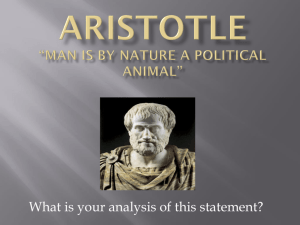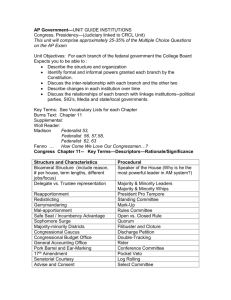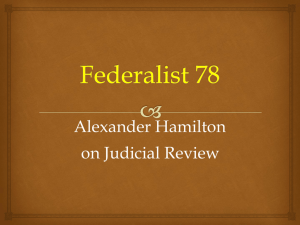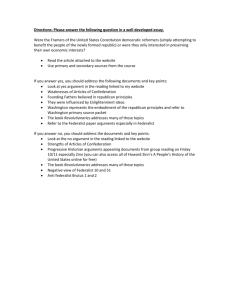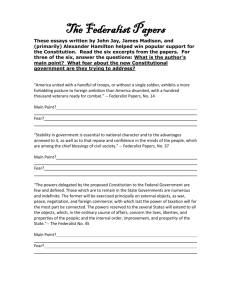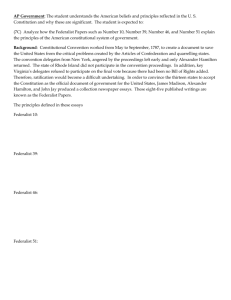10 Constitutional Convention
advertisement
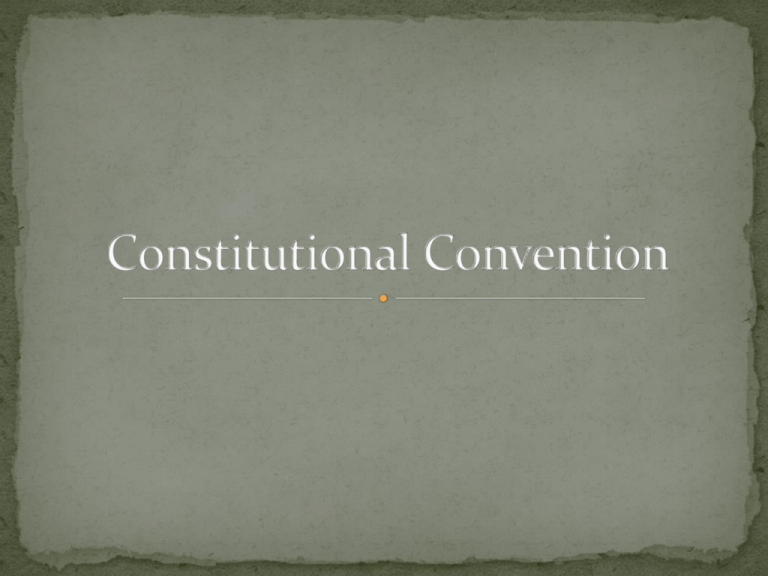
To understand, need to put self in 1780’s. (the mentality of the Founders). It had been a world of emperors – not democracies. The US was down the list of powerful countries – surrounded by enemies. They had to conduct a “political cleansing”. Spain was the most hated. The US hated Roman Catholicism. Spain was the evil empire. The Mississippi River belonged to Spain. US had no navigational rights to the river. On the homefront, each state had to chose between anarchy and tyranny. Should the new government be federal or national? Should this new government be controlled by large or small states? How powerful should it be? These were totally different terms in the 18th century. Everyone wanted a republic (for the public good) and there were two types: Federal; federated republic; confederated (Federalist Papers #9). Works to control states, not the people (the United Nations is an example) National, unitary, consolidated republic. (Federalist Papers #17) The states would vanish; nothing between national government and the people. Federal – government of and by the states National – government by the people; by the people making the nation. Therefore, a central government can be a federal style or a national style. Resolution by Richard Henry Lee, June 11, 1776, created the United States. Say we need a new government – a plan of confederation to be drafted and written out. Britain was a national government. The King and Parliament had power over all individuals – and the founders did not want this. states remained (absolutely) sovereign over their own affairs. (Articles II and III) they did surrender limited powers (Article IX). An example was power over the Indians. State governments stood between Congress and individual citizens. (Art. VIII, para 2) established a government that could coordinate resources did not threaten the sovereignty of the states did so without threatening the lives, liberties and property of the citizens territory – can’t defend – Northwest Territories still had British; Spain was in the South and Southwest. The Continental Army had disbanded. Unpaid soldier mutinied. Bits of states tried to secede (ex: Vermont; and State of Franklin in Western NC) British sold tons of cheap goods to America; there was no power of protective tariffs. So, going deep in debt to the British. Domestic industries were going bust British closed the West Indies to trade States acting on their own – ex R.I. created inflation to help debtors. Creditors hated it. Shays’ Rebellion – merchants in Boston hired an army Dickinson and others began to feel that a federal government was not working and sought a national government. There were various ideas. Varying degrees of nationalism. A more unitary government. It began at Mount Vernon (Trade convention) and moved on to the Annapolis Convention and then Philadelphia. February 21, 1787 – a resolution in Congress called for revising the Articles (sole and expressed purpose was revision). Some refused to attend. Henry, Lee, Rhode Island. They “smelled a rat”. Every member was a variant of a nationalist. The term Federalist was not used until the ratification phase. From the start, it was a stacked deck. How strong shoud it be? Memories of the British remained strong!! Randolph (Virginia) Plan Paterson (New Jersey) Plan Hamilton Plan – didn’t get very far (Gunning Bedford and Alexander Hamilton – sir, we don’t trust you! A matter of trust!!) There were two forms of dividing power: equal or proportional. Equal – 27% of the population were in the 7 smallest states Proportional – 47% of the population were in the 3 largest states Weeks of debate! legislative branch choosing a president Electoral college: compromise between supporters of equal and proportional plans. If a tie, House of Reps would vote with each state receiving only one vote. Ratification process: Each state voted individually – 9 states needed Legislative Powers: enumerated, unenumerated, with limitations Executive Judicial Congress has the lion’s share of power can shut down the President and Supreme Court limited by elections every two years the Constitution was the “supreme law of the land” Nationalists didn’t want to call themselves nationalists (government directly over the people – no states). The term Federalist began as supporters of the Constitution – a nationalist constitution. The Anti-Federalists were the true federalists. (state sovereignty) tyranny - arbitrary or oppressive exercise of power – the absence of a bill of rights. consolidation – consolidation of the states into a single, national, system Evidence of tyranny – the absence of a bill of rights. There was no provision of civil trials. So, Article III, Sec 2. Also, the government could not grant any title of nobility, Article I, Sec 9. If we have to tell them this, what else do we need to tell them? The Federalist Papers #10. It was powerful, but could never become tyrannical: (a) the US is too big for consensus, and (b) the balance of power prevents it from becoming tyrannical. a. “We the people” – states have vanished (look at Articles of Conf.) b. Congress shall have power…general welfare…common defense (Sec 8) c. militia d. Supreme Court – one national court e. Article III, Sections 1 and 2 f. Supremacy clause It wasn’t really a national government and provided examples: the foundation – from the states the source – senate, elected by the state legislatures these are restrictions on its power amendment process (states, again) The deciding element – “pass it and we’ll amend it to fix it” The amendments addressed tyranny – just because we forgot it doesn’t mean it doesn’t exist. These are not all the liberties. (Federalists #9) Amendment 10 addresses the fear of consolidation. It reserves the power to the states. But, Madison left out the word “expressly” as in Article II of the Articles of Confederation. Federal power comes from the elastic clause.
